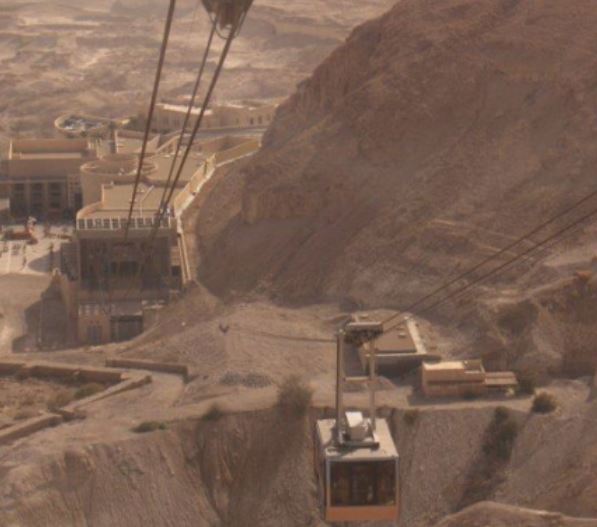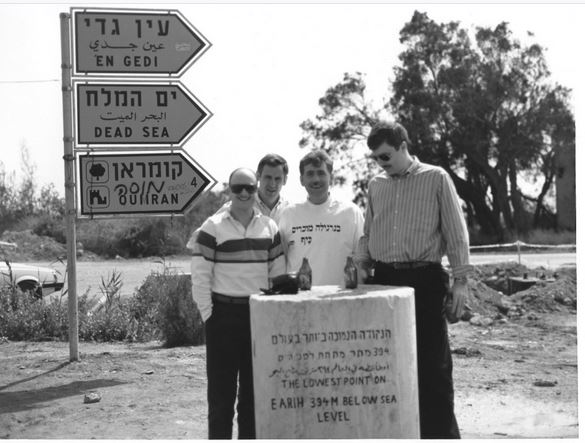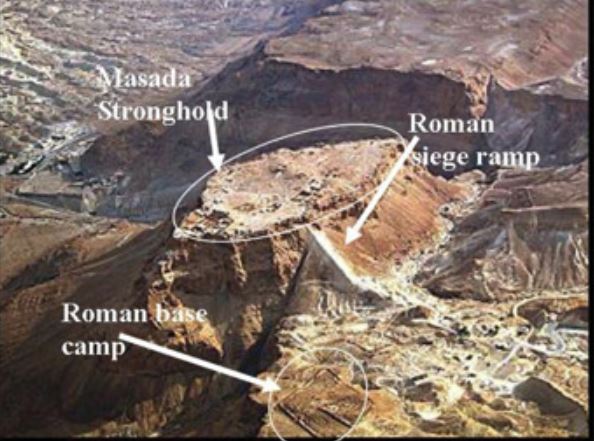Masada
Morning, Folks! There are the usual fits-and-starts outside in Virginia’s lush Piedmont as we drive into Spring. The waning moon gave us a glimmer as the sun came up. Pretty morning. The gang drifted out of sleep sacks for coffee and conversation at the Fire Ring not supervised by the Attorney who is supposed to watch us.
Accordingly, there was discussion bout the President’s three statements on goals and objectives while he was in Europe, and who it is, actually, who writes the corrections and clarifications here. Another string lurched off about food supplies, which we are told is going to get more expensive because of shortage, transportation issues in the supply chain. That is to be expected, since planting wheat in Ukraine, Europe’s breadbasket, is difficult while under rocket or artillery fire.
We can talk about the consequences for all that stuff as the reality of today turns into a much starker one as we approach what would have been the harvest this fall. That is the nature of war, and the small hope that there may be a sort of peace now that the assault seems to have run out of steam. With all that, some of which we are not supposed to talk about, we thought a journey into history might be fun. This is a about a remarkable place, regardless of the other issues that surround it. Some of the group saw it thirty years ago, but it is still there. This piece will be in the Alphabet Cities travel book we are working on. under “M.”
If you have a chance, stop by sometime. It is right by the Negev desert, so EZ-on, EZ-off.
– Vic
14 March 1990
This is from a time not so long ago, in a place that is half a world away.
Masada

(Masada Cable Car)
By 1030, it is clear that what we need is a road trip to clear the evil humors lurking in the temporal lobes from the night before. Chop and CAGMO are going to Tel Aviv to look for deep discount diamonds, so eight of us set off for Masada with CAG in the lead and Deputy on the Wing.
After some minor confusion in getting out of town we find the four-lane and blast off toward Jerusalem. I m navigating and the maps we have do not have route numbers on them, being more of the National Geographic persuasion than the usual filling station map. I have plenty of information on the map about the Dead Sea Scrolls but am hurting for the correct turns. We detour around the capital and head up the road for Jericho.

(Contrary to the way you might have felt about some of the places you have found yourself, this is the actual lowest place on Earth that has exposure to the sky. It has a stone that says so, and that is even better than the stuff on the Internet).
We roared through blasted nothingness. Bedouins living in tents just off the road. Sheep grazing on thorns on the ridge lines. Badlands. Then off the tabletop and we roll downhill, down through sea level, down to the lowest spot on earth.
At the base of the hill an enterprising Israeli has pulled in a trailer, erected an awning, placed some chairs and opened the Lowest Diner in the World.
Lutt-man cracked that we should dig a basement for the place and open a bar. We could call it “The Scroll Lounge” and really have the lowest place ever.
We stop at the marker and have our pictures taken. The inscription on the side claims we are 415 meters, or 1362 feet, below sea level. Then we mount up again in the two sedans and take a right turn on Route One and head south, hugging the shore of the Dead Sea, the water brilliant blue, the barbed wire un-weathered on the security fence.
This is a place of raw, wild, blasted and unearthly beauty. After 55 Kilometers we see an immense flat-topped mesa in the distance. We are approaching Masada.
Masada occupies the entire top of an isolated mesa near the southwest shore of the Dead Sea. It is a rhomboid-shaped rock that towers 1,424 feet (434 m) above the level of the sea. Which means if the Med ever came this way in another Great Flood, the summit would be an island sticking up about eighty feet. The table-top of the mesa has an area of about 18 acres. Some authorities hold that the site was settled at the time of the First Temple (c. 900 BC), but of course that is not the time for which it is remembered.
This is the place of Herod the Builder, 37–4 BC, king of Judea under the Romans, and for its resistance to the Roman siege in AD 72–73.
Although other rulers liked the site as a place of refuge it was Herod who made it a royal citadel. His constructions included two ornate palaces (one of them on three levels), heavy walls, defensive towers, and aqueducts that brought water to cisterns holding nearly 200,000 gallons of potable water.
After Herod’s death (4 BC), the fort was captured by the Romans, but the Zealots, a Jewish sect that staunchly opposed domination by Rome, took it by surprise in AD 66. The steep slopes of the mountain made Masada impregnable.
Following the fall of Jerusalem and the destruction of the Second Temple (AD 70), the Masada garrison, last remnant of Jewish rule in Palestine, refused to surrender and was besieged by the Roman legion X Fretensis under Flavius Silva.
The Tenth- the Straits Legion- was raised by Augustus at the end of the Republic and was recorded as being in existence as late as 410 AD, which is not a bad run for a military outfit. Their symbols were the bull, the holy animal of the goddess Venus, a ship, the god Neptune, and a boar.
Masada was a tough nut, but the 10th Legion was taking no crap off the Jews. It took an army of nearly 15,000 legionnaires and almost two years to subdue the fortress. The assault was conducted by way of a sloping ramp of earth and stones to bring their soldiers within reach of the stronghold.
The defenders, a thousand men women and children, watched the ramp slowly mount up from the desert floor. Under the leadership of Eleazar ben Jair, the Zealots chose death over surrender, drawing lots for the order of their demise the night before the final attack was expected. When the sturdy legionnaires of the 10th pushed the wooden bridge over to join the ramp to the rampart, they found only two women and five children left alive to tell the tale of the mass suicide.
With brief interruptions in the 2nd, 5th and 6th centuries the place was abandoned until the creation of the State of Israel. The Arabs- and their Palestinian successors- called it As-Sabba (“The Accursed”).
What we saw from the car park below was the result of the excavations of Israeli archaeologists in the mid-1950s, the same time Egypt’s Nassar was pulling on the British Lion’s tail.
Throughout 1955 and 1956, Nasser pursued a number of policies that would frustrate British aims throughout the Middle East. He began to align Egypt with the Saudis, whose Royal Family was the hereditary enemy of the Hashemites of Jordan- and recently enough, the rulers of the Transjordanian soil on which we stood.
The British were ultimately ejected from the region they had ruled since World War One, and the Israelis began the remarkable transformation of their new state. The initial digs at Masada were followed by a massive effort in the early 1960’s, and orchestrated by a man named Yigael Yadin, assisted by thousands of volunteers from around the world.
In the 20th century Masada became a symbol of Jewish national heroism, and it is now one of Israel’s most popular tourist attractions, and a place where newly-commissioned IDF officer take their oath of allegiance with low fly-bys by IAF jets coming out of the Negev Desert.
We could have taken the “Snake Path” that winds up 900 ft to gain access to the lower fortress. We were touring, though, not on a pilgrimage. We took the cable car 1900 feet to the top. We wandered past the storehouses, looked at the palaces, and the cistern that still contained water. The sun is brilliant and the breeze refreshing. Among other wonders in a day filled with the extraordinary, I walk into the oldest extant Synagogue, one that served this garrison in the days of the Second Temple.

(Masada Annoted)
At the western edge of the plateau, we looked down at the Roman siege lines that snake six miles around the base of the mountain and sealed the occupants up as the assault ramp was built.
Looking down, the outline of the Castra (military camps) are distinct. It is as if the last 1900 years never happened. The Roman ramp has weathered a bit, but it is right there, in your face, just at the Zealots last saw it.
It is eerie and real and tremendously moving. As we gazed down at the assault route I confess to CAG that I found myself drawn more to the solders of the 10th Legion who invested the place than to the Zealots who defended it.
The Carrier Air Group Commander smiled that enigmatic smile of his and said softly “I was IN the 10TH Legion.”
There was a flat on the car’s tire on the highway headed back north; after some minor excitement in trying to find out where the spare was hidden, we blasted on.
The ride back to Tel Aviv was long and I dozed. Attempting to see the entire Bible in four days is a challenge. When awake, I provided erroneous directions to the hotel but we made it anyway.
Copyright 2022 Vic Socotra
www.vicsocotra.com
